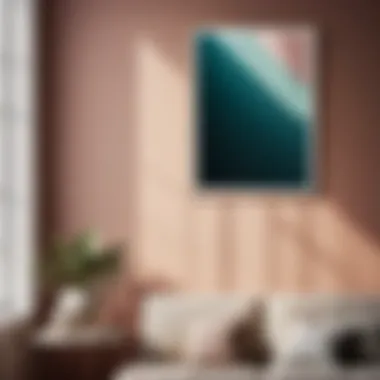Illuminate Your Space: A Comprehensive Guide to Elevating Room Ambiance with Wall Colors


Materials:
- Paintbrushes (2-inch wide and 1-inch wide)
- Painter's tape
- Drop cloths or plastic sheeting
- Primer
- Paint rollers
- Ladder
- Paint trays
- Various paint colors (light shades recommended)
DIY Steps:
- Start by clearing the room of furniture and covering the floor with drop cloths or plastic sheeting to protect it from paint spills.
- Use painter's tape to mask off areas you don't want to paint, such as trim or windows.
- Apply a layer of primer to the walls to ensure the paint adheres well and to cover any imperfections.
- Select your paint colors carefully, choosing lighter shades to brighten up the space. Consider warm tones like soft yellows or light greys.
Technical Aspects:
- Tools: Ensure you have high-quality paintbrushes, paint rollers, a ladder for reaching high areas, and paint trays for easy access to paint.
- Timing: Plan your project for a time when you can work uninterrupted, as painting requires focus and attention to detail.
- Techniques: Use long, even strokes when painting to achieve a smooth finish. Start from the top of the wall and work your way down for best results.
DIY Project Process:


- Begin by cutting in (painting the corners and edges) with a small brush before using a roller for the larger wall areas.
- Apply the first coat of paint evenly across the walls, allowing it to dry completely before applying a second coat if needed.
- For a professional look, remove the painter's tape carefully once the paint is dry to avoid peeling.
Troubleshooting Tips:


- If the paint is too thick, add a small amount of water to thin it out for easier application.
- In case of drips or streaks, gently sand the affected area once the paint is dry and reapply as needed.
Introduction


Moreover, we will discuss the art of selecting the right color scheme to achieve a harmonious and visually appealing living space. From exploring harmonious combinations to contrasting options for a more impactful look, this guide will provide practical tips for choosing wall colors that best suit individual preferences and room sizes. With the aim of helping housewives and homeowners create spaces that reflect their personalities and style, this article goes beyond surface-level recommendations, offering in-depth analysis and thoughtful considerations for each step of the color selection process.
By the end of this article, readers will be equipped with the knowledge and inspiration needed to confidently embark on their journey of brightening up their living spaces through strategic wall color choices.
Understanding Color Psychology
In the realm of interior design, Understanding Color Psychology plays a pivotal role in creating a harmonious and visually appealing space. When selecting wall colors to enhance room ambiance, delving into color psychology can offer valuable insights into the emotional and psychological impact of different hues. By understanding how colors influence mood and perception, homeowners can strategically choose shades that not only brighten up their space but also evoke desired feelings and atmospheres. This section dives deep into the significance of Understanding Color Psychology in the context of brightening room ambiance, providing readers with a foundation to make informed color choices for their living environments.
Psychological Effects of Color
Warm Colors vs. Cool Colors
When exploring the Psychological Effects of Color, the distinction between Warm Colors and Cool Colors emerges as a critical aspect to consider. Warm Colors, such as reds, oranges, and yellows, are known for their vibrant and energetic qualities, injecting spaces with warmth and vitality. In contrast, Cool Colors like blues, greens, and purples exude calmness and tranquility, ideal for creating relaxing retreats within the home. Each category carries unique characteristics; Warm Colors tend to be stimulating and invigorating, while Cool Colors have a soothing and refreshing appeal. In the context of brightening room ambiance, the choice between Warm and Cool Colors can significantly impact the overall mood and atmosphere, influencing how light interacts with the space and how individuals perceive the room's brightness.
Impact on Mood and Perception
Exploring the Impact on Mood and Perception reveals the profound influence colors have on our emotional state and cognitive processes. Warm Colors tend to evoke feelings of coziness and intimacy, making them ideal for creating inviting spaces in areas like living rooms or dining areas. On the other hand, Cool Colors have a calming effect, promoting relaxation and concentration, making them well-suited for bedrooms or home offices. By strategically leveraging the impact of color on mood and perception, homeowners can tailor their color choices to enhance specific room functionalities and cater to individual preferences. Understanding how colors affect mood and perception is crucial in the context of brightening room ambiance, as it allows for the creation of atmospheres that uplift spirits, foster productivity, or instill a sense of peacefulness within the home.
Choosing the Right Color Scheme
In the process of selecting wall colors to brighten up a space, Choosing the Right Color Scheme can make a substantial difference in the final outcome. By exploring Harmonious Combinations and Contrasting Options for Impact, homeowners can navigate the vast sea of color choices to create a cohesive and visually stimulating environment that suits their style and preferences.
Harmonious Combinations
When discussing Harmonious Combinations, the focus lies on selecting colors that seamlessly blend together to create a sense of balance and unity in a room. Harmonious color schemes often consist of colors that are adjacent on the color wheel or share similar undertones, resulting in a space that feels cohesive and harmonious. By opting for harmonious combinations, homeowners can achieve a serene and polished look that brightens up the room without overwhelming the senses.
Contrasting Options for Impact
On the contrary, Contrasting Options for Impact offer a more dynamic and vibrant approach to color selection. By juxtaposing colors that are opposite each other on the color wheel or have stark differences in lightness and darkness, homeowners can create striking focal points and visual interest within their space. Contrasting color schemes inject energy and personality into a room, making them ideal for those looking to make a bold statement with their wall colors. However, careful consideration is needed to ensure a harmonious balance between the contrasting hues, as an overly eclectic palette might disrupt the intended ambiance of the space.
Brightening Small Spaces
To create a welcoming and spacious feel within small rooms, choosing the right wall colors is essential. Small spaces can sometimes feel cramped or dark, but with the strategic use of color, they can be transformed into airy and bright areas. Opting for light neutrals is a popular choice for small rooms as these hues have the ability to reflect natural light, making the space appear larger and more open. Light neutrals such as soft whites, beiges, and light grays create a sense of tranquility and can also serve as a versatile backdrop for different decor styles. On the other hand, soft pastels, like pale blues, gentle greens, and blush pinks, can add a subtle pop of color without overwhelming the room. These hues bring a touch of warmth and coziness while maintaining a sense of airiness. When selecting wall colors for small rooms, it's important to consider the amount of natural light the space receives and how the chosen hues will interact with the existing furniture and decor.
Optimal Hues for Small Rooms
Light Neutrals
Light neutrals play a crucial role in brightening up small rooms by bouncing light around the space, creating an illusion of expansiveness. Their understated elegance and versatility make them ideal for small spaces, as they provide a soothing backdrop while allowing other elements in the room to stand out. Light neutrals work seamlessly with various interior styles, from modern minimalist to cozy farmhouse, making them a popular choice for homeowners looking to open up their space. Despite their benefits, it's essential to be mindful of the undertones of light neutrals to ensure they complement the room's furnishings and enhance the desired ambiance.
Soft Pastels
Soft pastels offer a subtle yet impactful way to infuse color into small rooms while maintaining a light and airy feel. These gentle hues, reminiscent of soft sunsets and blooming flowers, bring a sense of serenity and sweetness to any space. Soft pastels can introduce a touch of personality without overwhelming the room, making them perfect for creating a cozy and inviting atmosphere. They work particularly well in bedrooms, nurseries, and reading nooks, where a calming ambiance is paramount. When using soft pastels, it's essential to balance them with complementary shades and textures to ensure a harmonious and visually appealing space.
Creating Illusions of Space
Vertical Stripes
Incorporating vertical stripes on walls is an effective technique to visually elongate the height of a room, making it appear taller and more spacious. Vertical stripes draw the eye upward, creating an illusion of higher ceilings and a grander scale within the space. When choosing colors for vertical stripes, opt for tonal variations or subtle contrasts to maintain a cohesive look while adding visual interest. Whether painted directly on the walls or introduced through wallpaper, vertical stripes can redefine the proportions of a room and enhance its overall sense of openness and airiness.
Reflective Surfaces
Utilizing reflective surfaces in small rooms can amplify the natural light and create a luminous atmosphere that enhances the room's perceived size. Mirrored accents, glossy finishes, and metallic elements reflect light, producing a radiant glow that illuminates the space. When strategically placed, reflective surfaces can bounce light around the room, reducing shadows and making it feel more expansive and inviting. Incorporating mirrors, glass tabletops, or polished metals can add a touch of glamour and sophistication while maximizing the room's luminosity and visual depth.
Energizing Large Rooms
Energizing large rooms is a crucial aspect when it comes to enhancing room ambiance. Large spaces present a unique opportunity to play with vibrant colors and create a lively atmosphere that uplifts the entire room. The significance of energizing large rooms in this article lies in its ability to transform expansive areas into dynamic and engaging environments. By understanding how to utilize color effectively in larger spaces, homeowners can elevate the mood and energy of the room to make it more inviting and visually stimulating.
Vibrant Colors for Impact
Bold Accent Walls
Bold accent walls play a pivotal role in creating focal points within large rooms. They offer a striking contrast to the surrounding walls, injecting a burst of color and personality into the space. The key characteristic of bold accent walls is their ability to create visual interest and add depth to the room. By incorporating a bold accent wall, homeowners can instantly revitalize the look of their room and make a bold design statement. While bold accent walls can make a room visually appealing, it is essential to balance them with the overall color scheme to avoid overwhelming the space.
Rich Jewel Tones
Rich jewel tones bring a sense of sophistication and luxury to large rooms. These colors, inspired by precious gemstones, add depth and richness to the room's decor. The key characteristic of rich jewel tones is their ability to create a sense of opulence and elegance. Incorporating rich jewel tones into a large room can evoke a sense of glamour and create a refined ambiance. However, it's important to use these colors strategically to prevent the space from feeling too dark or overwhelming. The unique feature of rich jewel tones is their capacity to add a touch of drama and warmth to the room, making it feel cozy and inviting.
Balancing Light and Dark Shades
Contrast Techniques
Contrast techniques play a vital role in balancing light and dark shades in a large room. By incorporating contrasting colors, homeowners can create visual appeal and add dimension to the space. The key characteristic of using contrast techniques is their ability to highlight specific areas and create a sense of visual balance. Whether through color blocking, furniture choices, or decor accents, contrast techniques help to accentuate the room's features and enhance its overall aesthetic. While contrast techniques can make a room captivating, it's essential to maintain harmony between the different elements to ensure a cohesive look.
Incorporating Natural Light
Incorporating natural light is essential in balancing light and dark shades in a large room. Natural light not only brightens up the space but also enhances the visibility of colors and textures. The key characteristic of incorporating natural light is its ability to create a sense of openness and airiness within the room. By maximizing natural light sources through strategically placed windows or skylights, homeowners can create a sense of connection to the outdoors and promote a more relaxed atmosphere. The unique feature of incorporating natural light is its ability to amplify the room's colors naturally, making them appear vibrant and true to form. While natural light is beneficial for rooms, it's important to consider the placement of furniture and window treatments to optimize both light and privacy.
Infusing Personality with Colors
Incorporating personal style and preferences into interior design is crucial for creating a living space that truly feels like home. The topic of infusing personality with colors within this article delves into the significant role that individualized color choices play in transforming a room's ambiance. By selecting hues that resonate with one's unique taste and character, a sense of personal touch and comfort can be infused into the living space, elevating it beyond mere functionality to a place of self-expression and emotional connection. This section not only emphasizes the transformative power of color but also underscores the importance of integrating personal flair into one's living environment.
Expressing Individual Style
Personalizing Spaces
Personalizing spaces goes beyond mere decoration; it involves curating a living area that reflects one's identity, interests, and lifestyle. Whether through family photographs, cherished mementos, or custom furnishings, infusing personal elements into the decor creates a feeling of belonging and authenticity within the space. The beauty of personalizing spaces lies in its ability to evoke memories, spark joy, and foster a sense of individuality. By choosing colors that resonate with one's personal style, homeowners can create a living environment that is not only aesthetically pleasing but also deeply meaningful.
Artistic Color Choices
Artistic color choices offer a unique avenue for self-expression and creativity in interior design. By selecting bold color palettes, unusual combinations, or vibrant accents, homeowners can make a bold statement and infuse their living space with a touch of artistry. Artistic color choices lend a sense of dynamism, energy, and sophistication to a room, allowing individuals to showcase their creativity and taste. While unconventional color selections may require a careful balance to avoid overwhelming the space, they have the potential to imbue the room with character and originality, setting it apart as a truly personalized retreat.
Cultural Influences on Color Selection
Colors are not perceived in a vacuum but are deeply influenced by cultural norms, traditions, and trends. Understanding the impact of global color trends and regional preferences is essential for making informed color choices that resonate with a broader cultural context. By incorporating global color trends into interior design, homeowners can stay current with the latest styles and aesthetics that transcend geographical boundaries. On the other hand, considering regional preferences allows individuals to celebrate local heritage, traditions, and color symbolism, creating a space that is culturally rich and visually captivating.
Global Color Trends
Global color trends encompass popular color palettes, finishes, and textures that transcend borders and reflect international design preferences. By embracing global color trends, homeowners can ensure their living space reflects a contemporary and cosmopolitan aesthetic that is in tune with worldwide design sensibilities. Whether inspired by nature, technology, or social movements, global color trends offer a kaleidoscope of hues that cater to diverse tastes and design aspirations.
Regional Preferences
Regional preferences in color selection are deeply rooted in tradition, climate, history, and cultural symbolism unique to a specific geographic area. By honoring regional color preferences, homeowners can pay homage to local heritage, evoke a sense of place, and infuse their living space with a distinctive regional identity. Whether drawing inspiration from indigenous art, architecture, or landscapes, incorporating regional color palettes into interior design adds depth, authenticity, and a sense of connection to the surrounding environment.
Conclusion
When it comes to enhancing room ambiance through the use of wall colors, the importance of selecting the right hues cannot be overstated. In this article, we have delved deep into the impact of color psychology on mood and perception, highlighting the significance of choosing colors that align with the desired ambiance for your space. From the warm and inviting tones of light neutrals to the bold and impactful nature of jewel tones, each color choice plays a crucial role in transforming the look and feel of a room.
This comprehensive guide has provided insights into harmonious and contrasting color combinations, empowering readers to make informed decisions based on their preferences and the atmosphere they wish to create. By understanding how colors can affect the perception of space, whether by using reflective surfaces to enhance brightness or opting for vertical stripes to create the illusion of height, individuals can strategically design their rooms to appear more spacious and inviting.
Moreover, the exploration of vibrant colors for large rooms and the importance of balancing light and dark shades have equipped readers with the knowledge needed to energize and harmonize their living spaces effectively. By incorporating techniques that add depth and dimension, such as accent walls for a pop of color or natural light to illuminate the surroundings, homeowners can curate environments that reflect their unique personality and style.



